
MAY CONTAIN NUTS

Search Shorpy
SHORPY ART

Framed or unframed, desk size to sofa size, printed by us in Arizona and Alabama since 2007. Explore now.
Join and Share
Ad-Free Shorpy
Shorpy is funded by you. Patreon contributors get an ad-free experience.
Learn more.

Recent comments
- Hudson’s Big Store
- Say what??
- Grapes?!
- A Beautiful Moment
- Such joy
- Bethune-Cookman University today...
- Yellow sky at morning
- Side Winder
- Air Quality?
- Sojourner Truth riot
- None were so blind(ed)
- The less famous sister
- Good ol' days?
- Rise and Fall
- Goo Goo Ga Joob
- Ticket Retention
- Not the only one
- Vagaries of War
- Killed by Amtrak
- Back to the Future
- Wanted --
- If you can't stand the light
- Centralized Traffic Control, I believe
- What's really happening
- Heckuva remote control!
- Sometimes — Things Go Bump!
- I SEE THE LIGHT
- Union Switch and Signal Company
- Get That Light Out Of My Eyes
- Eggs. Eggs. Eggs. The Egg Man is Here!
Member Photos
The Shorpy
Print Emporium
Print Emporium
Search Shorpy
Search results -- 30 results per page
- Great Lakes Engineering Works: 1906
- ... remember seeing those big rounded-square pails around the Pittsburgh area. The ones I recall (and I have one that my dad used) look ... Posted by Dave - 08/14/2012 - 2:12pm -
![Great Lakes Engineering Works: 1906 Ecorse, Michigan, circa 1906. "Great Lakes Engineering Works." Another look at this ship-building concern on the Detroit River near Lake Erie. 8x10 inch dry plate glass negative, Detroit Publishing Company. View full size.
OK, OK, lunch pailsThat had occurred to me, honest, but their apparent uniformity got me thinking some kind of company-supplied appurtenances, like tool boxes. Whatever they are, they sure are purty.
SmokestackingAs a young salesman I was taught the term "smokestacking," which meant that one could find possible new clients in an area by checking the skies for billowing plumes of black smoke and then following it to the source. This photo speaks to that mightily.
Shiny thingsSo, the white or extremely shiny things we see lined up along the walls or on window sills or being carried by the men; what the heck?
Re: Shiny thingsLook like lunchpails to me.
Re: Shiny thingsI could be wrong. I'm not sure. This is just a guess. They seem to me to be, should I be so bold to say. I really want to be right on this. If I had to wager on it. If you pin me down on this question. Lunch buckets!? Please tell me I'm not wrong. Have always been a risk taker. Just can't help it.
Shiny ObjectsThey are old style lunch pails.
http://www.lunchboxes.com/history.html
OK, They're Lunch BucketsAnd, there are at least four other men in the close proximity with Their Lunch Buckets. Got It! tterrace and jimmylee42 are way too smart for this dribble.
What I want to hear from are those more versed in Great Lakes History than I and tell us what this huge Ship Building enterprise, and so many other "Enterprises" did to the ecology of the Great Lakes as a whole.
After all, these Great Lakes, of which I live 15 miles from, contain 20% of all of the Fresh Water on this Planet!
Between Timber, Ore, Steel, Ship Building, and Over Fishing, and then Atlantic contamination, we have done our very best to destroy the Great Lakes.
PCWhy am I not surprised that my comment that this carbon spewing in 1906 should have kicked off "global warming" over a century ago, but didn't, did not get posted. I guess it's an inconvenient truth that this didn't cause global warming then, and it doesn't today.
[Perhaps you're not the only one who's not surprised. - Dave]
GLEW in the familyMy dad and my grandpa both worked at Great Lakes. Many other friends and family too. It put food on the table!
When was lunch launched?When I was a kid, in the 1940s, those were dinner pails. The noon meal was dinner, the evening, supper. I don't remember seeing those big rounded-square pails around the Pittsburgh area. The ones I recall (and I have one that my dad used) look sorta like a covered wagon: a boxy bottom and a rounded cover where a Thermos bottle was clamped. Miners had a different type of pail. It was big and round and they carried water in the bottom.
(The Gallery, Boats & Bridges, DPC)](https://www.shorpy.com/files/images/4a21315a.thumbnail.jpg)
- Bridge of Sighs: 1903
- Circa 1903. "Bridge of Sighs, Pittsburgh." Named after the famous span in Venice, it was used to transport ... Posted by Dave - 01/30/2013 - 5:52am -
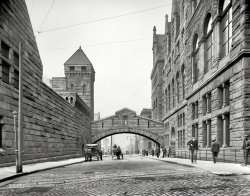
- Hop In: 1919
- ...
Licensed to Marry
...
Richard M. Boeckel, 24, Pittsburgh, Pa., and Florence M. Brewer, 30, Washington. The Rev. E.S. Dunlap. ... Posted by Dave - 08/28/2012 - 3:10pm -
![Hop In: 1919 Washington, D.C., circa 1919. "Mrs. Marsh, Mrs. Boeckel." Eleanor Taylor Marsh and Florence Brewer Boeckel of the National Woman's Party. View full size.
Cool RoadsterLooks like two nice women out riding in their sporty little two seat roadster. What is that car anyway?
V for victoryA card in the window on the right appears to say "V [for] Victory." I'm surprised, I thought that was a World War II slogan.
I am old but...I have been married twice and never wanted to be called "Mrs." How times have changed! Love the pic.
Miss Eleanor TaylorMiss Taylor appears to have dropped her early insistence on retaining her own name in marriage. I hope she wasn't so easily swayed to abandon other progressive notions she espoused. The following article is striking for the tone of wonder at a marriage based on equal partnership. Additionally, its hard to imagine a contemporary reporter questioning a woman about birth control.
Washington Post, Feb 21, 1917
Pretty Vassar Girl Keeps Own Name
As Party to "Individual Marriage."
Bride and Bridegroom Pay Share-and-Share-Alike for
Everything from Laundry to Movie Tickets
"Mr. Marsh and Miss Taylor" is Legend on Doorbell.
New York, Feb 20. — Pretty 21-year-old Eleanor Taylor, as attractive a girl as ever helped carry the daisy chain at Vassar College, has given prosaic Greenwich Village its latest excitement. From the quiet of the halls of the ancient seat of learning she has walked with bold and undaunted step into the very center of the "village" Bohemians. What has she done? She has entered into the latest of marital contracts with Benjamin Marsh, war correspondent, radical and seventeen years her senior, in what now becomes famous as the "Individual marriage."
The "individual" clause of the contract was added when Miss Taylor and Mr. Marsh — not Mr. and Mrs. Marsh — found themselves sipping tea in the cheerful home they had previously fixed up in the environs of Washington square.
In a word, the clause that makes a marriage in "individual" one is nothing to be scoffed at by the struggling artist who finds both ends hard to meet. True, it robs him of what many men glory in — dominion over his spouse — but it makes life less worrisome. It seems that the wife is to retain her individual rights, including everything. She does not even have to give up her name, her position, her thought, her work; nor does such a marriage permit a husband to support his wife. She supports herself, and Miss Eleanor Taylor and Benjamin C. Marsh are carrying their contract out to the letter. Each contributes equally toward the morning meal. Each has a job in New York.
At night they wend their respective ways home to 11 Vandam street. After comparing expenses for the day they go over to the Greenwich Settlement House, where they dine sumptuously for 35 cents each. As they stop at the cashier's desk on the way out, Miss Taylor pays her own check, Mr. Marsh his. To the "movies," a lecture or the theater, Miss Taylor pays for her ticket. Mr. Marsh pays for his.
"I met Mr. Marsh a year ago at the Greenwich Settlement House," said she. "Neither of us wanted to impose his belief on the other. We agreed in purpose, though. We decided on our mode of living, because we knew it would make us happier; all the more because each has his own work. We decided that each contribute to the support of the household. We figure out the cost of breakfast — just now it is 15 cents — and we divide the amount. We pay our laundry and other bills separately. No man, husband nor anyone else could make me change my individual thinking, and my name? On our doorbell we have Mr. Marsh and Miss Taylor."
"Do parties in individual marriages believe in birth control?" asked the interviewer as a final question. "I do," said Miss Taylor, frankly, as she bent over her desk to resume her work.
Washington Post, Dec 9, 1968
Eleanor T. Nelson, Crusader, 73, Dies
Eleanor Taylor Nelson, 73, an early crusader for women's suffrage, died yesterday at George Washington University Hospital after a stroke.
Mrs. Nelson was a publicist for the National Woman's party, which was instrumental in getting Congress to pass the 19th Amendment in 1919. In the early 1920s she was a public information officer for the U.S. Children's Bureau and was a founding member of the Women's National Press Club.
Mrs. Nelson moved to New York City in 1927 and worked for many years as a copy writer for the J. Walter Thompson Co. advertising agency.
She was married to the late Benjamin C. Marsh, the late Horace Wylie and the late Ralph Nelson. She returned to Washington several years ago and lived at 2101 16th st n.w.
She is survived by a son, Michael Marsh, of Washington; a daughter, Mrs. Wallace Scott, of Bennington, Vt.; a brother, James I. Taylor, of Philadelphia; two sisters, Mrs. Ira Keller, of Portland, Ore. and Mrs. George K. Hourwich of New York City, and five granddaughters.
The caris a Reo.
Florence Brewer Boeckel
Washington Post, Oct 17, 1965
Florence Boeckel, 79, Suffragist and Editor
Florence Brewer Boeckel, a crusader for woman suffrage, who was an education director of the National Council for Prevention of War from 1921 to 1935, died early Saturday morning in Mar-Salle Convalescent Home, She was 79.
Mrs. Boeckel was born in Trenton, N.J., and graduated from Vassar College in 1908 before doing graduate work in Paris and Dresden. In 1910 she became a special investigator in the Poughkeepsie, N.Y., schools, and in 1911 joined the Poughkeepsie News-Press as a feature and editorial writer.
She was on the editorial staff of Vogue magazine in 1911 and 13 and was a feature writer for the Baltimore Sun in 1914 and 15. Between 1917 and 1920 Mrs. Boeckel was the publicity director of the National Woman's Party, aiding their drive for suffrage and from 1919 to 1920 she edited The Suffragist.
Mrs. Boeckel wrote two books: "Across Borderlines," 1926 and "Between War and Peace," 1928. Two earlier books, "Study of Occupations Open to Young Women" and "Through the Gateway," were published in 1911 and 1920.
In the 1930s Mrs. Boeckel wrote a weekly newspaper column called "Between War and Peace," and in 1936 was American delegate to the World Peace Congress in Brussels and attended the opening session of the Council and Assembly of the League of Nations in Geneva.
Mrs. Boeckel also was a founding member of the Women's National Press Club. She is survived by her husband, Richard, of the home at 2137 Leroy pl., nw., and by a son, John Hart of College Park Woods Md.
Washington Post, Jan 11, 1916
Licensed to Marry
...
Richard M. Boeckel, 24, Pittsburgh, Pa., and Florence M. Brewer, 30, Washington. The Rev. E.S. Dunlap.
...
REO AutomobileThe car is a 1916 - 1918 REO Four Passenger Roadster which cost $1250 in 1916. By 1918 the price was $1550.
For comparison, a Model T Runabout (2 Door) base price was $345 in 1916 and $500 in 1918. A Packard 2 Door Passenger Coupe was $2,700 in 1916 and $3,450 in 1918. Prices went up because of WWI and post-war inflation.
The REO is a six cylinder model. A Ford Model T is only a four cylinder engine and the Packard is a 12 cylinder.
The radiator with the front sloping forward is unique to REO. The 1918 REO slogan was "The Gold Standard of Values." The illustration below is from their 1916 Prestige brochure.
(The Gallery, Cars, Trucks, Buses, D.C., Harris + Ewing)](https://www.shorpy.com/files/images/12177a.thumbnail.jpg)
- Rust Belt Riviera: 1941
- ... west of this location. This view is looking east toward Pittsburgh from Rochester and likely was taken from the bridge crossing the ... Posted by Dave - 11/06/2019 - 1:36pm -
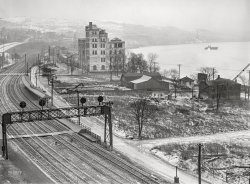
- Vegetarian Nut: 1926
- ... and also was fresh from a job with the Pet Milk Co. in Pittsburgh. The business then was located at 1339-41 South Capitol st., in the ... Posted by Dave - 08/05/2012 - 5:56pm -
![Vegetarian Nut: 1926 Washington, D.C., 1926. "Semmes Motor Co. -- Schindler's truck." From an interesting if moldy series of pictures showing Washington delivery trucks in their natural habitat of side streets and back alleys. Note the different varieties of "Wantmor" peanut butter sandwiches. National Photo Co. View full size.
Nuts to you!Inside:
Thanks, Dave!
BTW, In 1937, Ardil, peanut fibre, was created as I understand by separating the white inner layer from the shell and creating the fibre. Somewhere, I have a sample which my mother got, probably in 1946 when a plant was built in Dumfries, my mother's home town by Imperial Chemical Industries. I can recall it being a slightly yellowish white. It is now brownish and somewhat brittle.. Ardil production ceased in 1957.
http://www.pca.com.au/ardil-the-forgotten-fibre.php
LintelsPlease note the different lintels in the brick openings. The cut-stone lintel in the center is undoubtedly part of the original brick wall. As other openings (right and left) were needed, brick was cut away and I-beams, iron or steel, were used: not of the same character as the cut-stone.
DetailThe stone lintel over the entryway. The initials are a nice touch. I wonder whose?
[WAC = Washington Athletic Club. - Dave]
Man, that was good p-butter!Schindler's Nut Co. expired in the 1990s, I think. They supplied peanuts to the Baltimore baseball parks for many years.
But I remember them for their peanut butter. In the '50s, the only place that sold it was the mom-and-pop neighborhood groceries, no chains (at least none my mom shopped in).
I swear, you could lay block with that stuff, but I have never found any p.b. anywhere that tastes as good. About 20 years back, I got to wondering if they still made it, and called their office in Baltimore. The lady who answered the phone told me, "Sir, I've worked here for twenty-five years, and we haven't made peanut butter since I've been here." Yeah, and it wasn't delivered in a rig like this one, either.
Animal WritesIt's always interesting to see that the idea of a meatless diet is hardly a recent trend. Even the term Vegan goes back well into the 1940s.
[Writes with ... a pig pen? - Dave]
Perhaps a quill feather pen, this lettering looks pretty fancy.
Nutty Business
Washington Post, Jun 14, 1913
Stock Issue Authorized
The Vegetarian Food and Nut Company was incorporated yesterday, with a capital stock of $45,000, divided into 2,250 shares of the par value of $20 each.
The concern, the plant of which is located at 1307-15 South Capitol street, will acquire the business that has been conducted by Mrs. Belle Coleman, and continue the manufacture of vegetarian food products. Mrs. Coleman, W.H. Coleman, Miss F.M. Coleman, 1804 Riggs street northwest; J.H. Bilbrey, 1207 N street northwest, and A.L. Bowen, 742 Newton place northwest, will constitute the board of five directors that will manage the business the first year.
Advertisement, Washington Post, Jul 16, 1914
Vegetarian Food and Nut Company
W.H. Coleman, President,
Largest Exclusive Manufacturers of
Peanut Oil Products in America
General Offices and Factory,
South Capitol and N Streets
Conceded by Food Experts the Finest Made.
Sold by Nearly 2,000 Washington Grocers.
Specialties: Dr. Schindler's Peanut Oil Butter, Pure Sugar Syrup (maple flavor). Salted Peanuts.
Cable Address: Vegetarian, Washington, Long Distance, Phone Lincoln 2112.
Washington Post, Aug 14, 1921
Peanut Business Sold
The plant of the Vegetarian Food and Nut Company, manufacturers of Dr. Schindler's peanut butter, has been sold to Harry Rose, S. Sherry Stein and Louis Becker, who will continue to operate the plant. In addition to manufacturing peanut butter, salted peanuts are among the other products of the firm, which operates from a three-story plant located on South Capitol and M streets southwest.
Washington Post, Mar 12, 1933
Old Athletic Club, Now Plant, Burns
Peanut Butter Factory Fire Rages Next to 15,000 Gallons of Gasoline.
Having withstood the grunts and groans of wrestlers when it was the Business Men's Athletic Club more that 40 years ago and many years of use as Schindler's Peanut Butter Factory, one of the old Washington landmarks, at 1339 South Capitol street, succumbed to flames yesterday which seriously injured two firemen and endangered the whole neighborhood by their proximity to 15,000 gallons of gasoline.
…
The fire was said to have been started by a peanut cooker which was found in operation. Gas flames under it were thought to have boiled the peanut oil over the cooker and started the blaze.
Washington Post, Oct 21, 1956
Peanuts Hold High Rank with T. Earle Bourne
Schindler Concern Handles 4 Million Pounds a Year.
T. Earle Bourne is one man who won't complain if you tell him his business is peanuts. He feels it's "the nuts" in a big way — almost four million pounds of nuts a year, in fact.
Bourne is president of Schindler's Peanut Products, Inc. and has been since he roasted his first peanut in a commercial way in 1924.
The great Negro scientist George Washington Carver, proved that man could make more than 200 products out of peanuts, but Bourne is content to make just one thing — money. Schindler's does more than $1 million worth of business a year, which every will agree isn't … well, but it is.
Schindler's was started around 1900 by a Washington doctor name Schindler who called the business the Vegetarian Food and Nut Co. It had an extremely practical purpose in those days. The good doctor manufactured raw peanut butter which he ladled out in large doses to constipated patients with excellent results.
Bourne took over in 1924 when the owner, William S. Coleman, died. Bourne had been working with his father, James F. Bourne, in a Baltimore food brokerage business and also was fresh from a job with the Pet Milk Co. in Pittsburgh. The business then was located at 1339-41 South Capitol st., in the old southeast Athletic Club building. Bourne kept it there until 1941 when he bought land at 18th and Bryan sts. ne. He wanted to build there but wartime difficulties changed his mind and he decided to buy a ready-made building. He could find nothing to suit his wants in Washington so he bought a building at 500-26 S. Fulton ave. in Baltimore. There the peanut plant has remained. However, Bourne has always maintained his business headquarters in Greater Washington and moved into his present offices at 3711 Rhode Island ave., Mt. Rainer, in 1954.
New equipment was purchased for the Baltimore plant during and after World War II and an addition to the plant was constructed in 1944. The expansion decreased the warehouse space, so Bourne stores his peanuts in Suffolk, Va.
Schindler's buys peanuts from shelling and cleaning plants located near the peanut farms in Florida, Alabama, Georgia, South Carolina, North Carolina and Virginia. These nuts, plus cashews, filberts, almonds, pecans, Brazil nuts, English walnuts and black nuts come flooding in to the plant in Baltimore and go out as salted peanuts, peanut butter and peanut butter sandwiches (in cracker form). Most of the nuts, except peanuts, come from abroad through wholesale dealers and importers. Filberts, for example, come mostly from Turkey.
The nuts are sold to vending machine operators, chain grocery and drug stores and other retail outlets in bags, vacuum tins, and in 30-pound bulk boxes. Schindler's market includes 10 states on the Eastern Seaboard, Puerto Rico, Bermuda and the Panama Canal area.
Bourne also sells raw nuts to candy makers and does a thriving by-product business by dispensing the peanut hearts to wholesale feed dealers for wild bird food and to oil mills for peanut oil, a high quality vegetable oil. Farmers buy peanut skins for stock feed.
The 59-year-old Bourne didn't think much about peanuts after graduating from Baltimore Polytechnic Institute in 1915. He went to work selling beds and then enlisted in the Navy in 1917. He emerged in 1919 as an ensign and went to work for his father.
[Notes: In 1921, Dr. Schindler's Peanut Butter sold for 21 cents a pound. Schindler's stopped manufacturing peanut butter about 1968.]
RE: detailI saw this logo on a truck yesterday and realized I had seen it here. I think this building must have been part of Central Armature Works.
(The Gallery, Cars, Trucks, Buses, D.C., Natl Photo)](https://www.shorpy.com/files/images/32467u.thumbnail.jpg)
- Desk Lamp: 1938
- ... He lived in Washington.
Mr. Barbrow was born in Pittsburgh. He earned a degree in physics from Carnegie Institute of ... Blanche Wallace of Washington, a daughter, Jane Lobl of Pittsburgh, and three grandchildren.
A shocking experience Judging by ... Posted by Dave - 07/23/2012 - 10:53am -
![Desk Lamp: 1938 March 21, 1938. Washington, D.C. "Purchasing on an average of 4 million electric light bulbs annually, Uncle Sam is probably one of the largest users of light in the country. The National Bureau of Standards sees that the government gets value received in purchases by continually testing the incandescent lamps to determine their life and the amount of light they give. Using a special machine designed by the Bureau, Louis Barbrow is shown measuring the amount of light given by a lamp." Harris & Ewing Collection glass negative. View full size.
Lumen Counter
Obituaries, Washington Post, Nov 24, 1986
Louis E. Barbrow
81, a retired chief of the National Bureau of Standards optics metrology branch, died Nov. 20 at Providence Hospital after a heart attack. He lived in Washington.
Mr. Barbrow was born in Pittsburgh. He earned a degree in physics from Carnegie Institute of Technology in 1926. He moved to the Washington area in 1927 and joined the NBS, where he specialized in measurement [of] radiation, light and color.
He had served as chief of the photometry and colorimetry section and was chief of optics and metrology when he retired in 1969. In 1967, he was secretary of the U.S. delegation to the International Conference on Illumination.
Since retiring, he had been a consultant to the NBS Office of Weights and Measures.
Mr. Barbrow was a Mason, a past chairman of the American National Standards Committee, a past secretary of the metric practice committee of the American National Metric Council, and a member of the metric advisory committee of the Society of Automotive Engineering.
Survivors include his wife, the former Blanche Wallace of Washington, a daughter, Jane Lobl of Pittsburgh, and three grandchildren.
A shocking experienceJudging by all the bare wires and exposed splices, one could have an enlightening experience even without a light bulb.
The dark sphere reminds me of the sci-fi movie The Fly.
Idea ManThis guy obviously has many good ideas just waiting to be developed for cartoon characters.
IntegrationThe 'ball' is an Integrating Sphere, used to measure the various characteristics of light sources, especially 'power output' - luminous intensity, etc.
The device is painted inside with very carefully controlled reflective paint, and the optical radiation (infra-red, visible, or ultra-violet) from a test lamp can be measured with photocells, etc., without regard to what portion of, and what direction, the energy is coming from.
If you wished to measure the water flow from a lawn sprinkler, but only had a small cup to use, the measurement would be very inaccurate because only the streams coming toward you would go in the cup, the rest would be 'lost' on the lawn. So you'd have to move around the entire spray pattern in a known and timed manner, take lots of small measurements, and factor all that in, -OR- you could just put the whole sprinkler in a closed box with a single drain, and do your flow measurements using that.
The integrating sphere does this for light sources, it 'collects' (integrates) the output in a known and controlled way, and eliminates directional errors.
http://en.wikipedia.org/wiki/Integrating_sphere
Although primarily an electronics engineer, I have done some work with illumination systems, and still have the small sphere I bought surplus years ago on my shelves, along with the other piles of "stuff".
As for the exposed knife switches and variable resistors (the long round tubes with sliding knobs on the top) - yeah, that was pretty dangerous - and all the circuits were two-wire, no real grounds from the mains... you had to be careful and pay attention or your gear taught you a lesson. :)
Henceforth... the $45 light bulb!
(Technology, The Gallery, D.C., Harris + Ewing)](https://www.shorpy.com/files/images/24279a.thumbnail.jpg)
- Municipal Elevator: 1940
- ... I visited Dubuque but missed this. I did however, ride Pittsburgh's Duquesne Incline on a March day so cold, tourists from Canada were ... Posted by Dave - 12/10/2019 - 1:29pm -
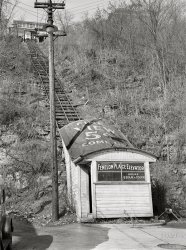
- Video Noir: 1948
- ... stations still on-air under new owners in New York, Pittsburgh, and Washington, only WTTG has retained the original call letters ... Posted by Dave - 05/08/2015 - 7:19pm -
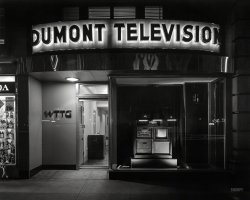
- Mad Men: 1957
- ... sure in the minority. When I taught at the University of Pittsburgh in the 1980s suits were standard wear. I always felt spiffy and ... Posted by Dave - 12/01/2019 - 2:55pm -
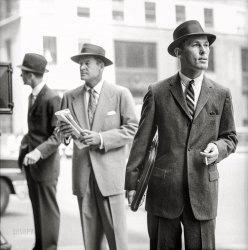
- Heavy Lifting: 1910
- ... and then were surplus due to the huge PRR (Cleveland & Pittsburgh) operation with its four massive Hullett unloaders just across the old river bed.
Those Pittsburgh & Lake Erie hoppers likely brought coking coal to Cleveland, and ... Posted by Dave - 08/01/2014 - 9:05am -
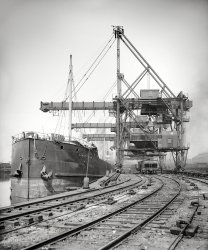
- Radio Ward: 1924
- ... also been achieved with WGY, at Schenectady, and KDKA, at Pittsburgh, and they are frequently on the Walter Reed Program. Sunday nights, ... set, so that the loud speaker audience may be listening to Pittsburgh, while the bed audience is enjoying WCAP. …
... Posted by Dave - 07/03/2013 - 10:33am -
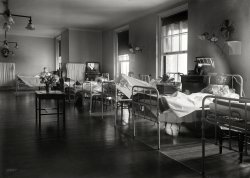
- York Village: 1908
- ... pretty certain the trolley was standard gauge. I live in Pittsburgh where the trolley gauge was 5 feet 2-1/2 inches. It looks much ... Posted by Dave - 09/18/2012 - 11:45am -
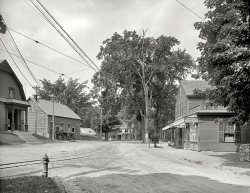
- Made in America: 1942
- ... during the war. They had factories in Illinois as well as Pittsburgh.
Tableside Apparatus Can anyone please tell me what the ... Posted by Dave - 10/03/2017 - 12:11pm -
![Made in America: 1942 June 1942. Chicago, Illinois. "Manpower. Americans all. His war job with Pressed Steel Can Car Company gives Michael Kassalo an extra good appetite. Operating a vertical turret lathe in a Midwest tank plant, Michael is one of many hundreds of first- and second-generation Americans whose sole purpose during working hours is to get as many tanks as possible off the lines and ready for shipment to the fighting fronts. Michael's grandparents, with whom he lives, cling to the Slavic language and to many 'Old Country' customs, but Michael and his brothers and sisters are as American as the Smiths and Joneses." Photo by Ann Rosener for the Office of War Information. View full size.
Pressed Steel CAR Co.The original photo caption seems to have a typo. It most likely meant to reference the Pressed Steel Car Co., which was a major builder of railway equipment and did indeed convert to the production of tanks and other armored vehicles during the war. They had factories in Illinois as well as Pittsburgh.
Tableside ApparatusCan anyone please tell me what the apparatus in the foreground is? It looks like something used to cook food at the tableside and has a vent pipe but I don't believe I have ever seen anything like it. How was it used? Very interesting picture.
Michael reaches for ...... a handful of jellyfish?
What IS that stuff?
[He's reaching into a cellophane bag or wrapper. -tterrace]
[For a slice of "California-Style" HoneyWheat Bread. - Dave]
Laundry stoveUsed to be common in kitchens:
Our family cooked on oneOur family cooked on one of those stoves during the war! My parents rented a house in 1944 in which the owners had removed the modern range. Left was a version of this stove in the kitchen. It doubled as the source of heat for the hot water heater. Having no oven, my grandmother used a stovetop oven (no thermostat of course) to bake rolls, pies and cornbread. All the stovetop cooking was done on that small stove, which was fired by coal. In the summers, our kitchen was one hot place, as the house was in South Alabama and of course there was no air conditioning!
(The Gallery, Ann Rosener, Chicago, Kitchens etc., WW2)](https://www.shorpy.com/files/images/SHORPY-8b07381a.thumbnail.jpg)
- Rules of the Sale: 1920
- ... locations, culled from multiple sources, seem to have been Pittsburgh, Akron, Indianapolis, Flint, and Detroit.
(The Gallery, D.C., ... Posted by Dave - 05/29/2018 - 9:39pm -
![Rules of the Sale: 1920 Washington, D.C., circa 1920. "Conbro clothing store, interior." Happy shopping, everyone. National Photo Company glass negative. View full size.
And free alterations too!A couple of the salesmen have tape measures around their necks so they can make the clothes fit perfectly. This looks like the wedding gown sale at Filene's except they are all men and it may be a summer clearance since they are wearing straw hats. Imagine, not a single domineering wife or girlfriend is visible in there to tell her guy what to wear.
[It's spring ("spring suits," palm fronds). - Dave]
Re: "free alterations"I take that back. After further scrutiny, I see ONE "battle-axe" facing the camera who IS going to have a voice in her man's attire. She's wearing earrings and a turned-up brim. Sorry.
"Sale" prices?Wow! For a clearance sale, these seem lofty for the time!
Today, that $24.44 suit (or jacket?) would cost $262, using the Consumer Price Index, or $1350 (!!) using GDP Per Capita, an estimate of "affordability."
AlterationsWell of course you could get alterations, but they're not included in the sale price.
A week's pay for a pair of pantsI was surprised by the prices as well. This illustrates how much we would all likely be paying for clothes right now if they were all still made in the USA.
Mystery SolvedCONBRO Clothes, which was located at 930 F Street NW, was next to the Metropolitan Theatre. It appears to have been in business for approximately one year with advertisements for the store starting to surface in local newspapers in December 1919. This store was managed by Jack H. Koppelman. A fire at their warehouse at 116 E Baltimore Street, in Baltimore, Maryland, preceded the sale scene shown in the photo here and in the sale announcement below from the Washington Times on August 4, 1920. No date for the fire was given in the other ad.
Conbro claimed there were a total of 10 stores in the chain, but no details of other locations were provided. Possible locations, culled from multiple sources, seem to have been Pittsburgh, Akron, Indianapolis, Flint, and Detroit.
(The Gallery, D.C., Natl Photo, Stores & Markets)](https://www.shorpy.com/files/images/29306u.thumbnail.jpg)
- Whaleback: 1910
- ... When owned by Bessemer Steamship Corp. and then Pittsburgh Steamship Co., it was based in Duluth. This barge was part of a ... Posted by Dave - 03/30/2014 - 12:41pm -
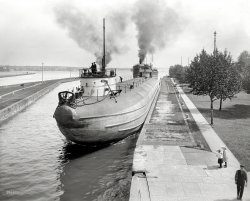
- Earl Smith: 192x
- ... to Retrosheet, on June 9, 1923 the Giants played at Pittsburgh. Images of Forbes Field do not match the upper deck facade as shown ... Posted by Dave - 09/09/2011 - 11:36am -
![Earl Smith: 192x Earl Smith, New York National League (Giants). Date written on this glass-plate negative is June 9, 1923. Although another from this 5181 series of pictures taken at the Polo Grounds has "5/13/20" scratched into the emulsion. View full size. 5x7 glass negative, George Grantham Bain Collection.
1920? 1923?According to Retrosheet, on June 9, 1923 the Giants played at Pittsburgh. Images of Forbes Field do not match the upper deck facade as shown here.
Retrosheet shows the Giants at Cincinnati on 5/13/20, and Crosley Field (called Redland Field in 1912-1933) appears similar (see http://www.viewimages.com/Search.aspx?mid=71652668 for an example from 1938), but not identical.
However, the Polo Grounds does match (http://www.dugout-memories.com/goffpol7.html).
So it appears the game was in New York, but on neither date given. I'm stumped without knowing who the opponent is.
[It's definitely the Polo Grounds. Another shot from this series shows Pete Kilduff of Brooklyn there on what would seem to be the same sparsely attended day. - Dave]
So it's 1920According to Baseball-Reference.com Pete Kilduff retired after the 1921 season, playing for the Brooklyn Dodgers/Robins in 20 and 21. Let's check 1920.
Retrosheet shows the Giants hosting Brooklyn on May 5-7 1920, just days before the May 13 date given. May would also fit with the low attendence, since school would still be in session.
Oh, the Giants took 2 of 3 against Brookyn that week but finished 7 games behind the Robins, with Brooklyn losing the World Series 5-2 to Tris Speaker's Cleveland Indians.
Thanks for the lead on Kilduff, Dave.
Could this...possibly be a photo of pre-game batting practice? The catcher appears to be wearing the same style/color uniform as Earl, the "crowd" is a bit sparse and that filthy home plate would bring shame to any whiskbroom-toting umpire.
(Note: in 1923, Smith only appeared in 24 games for the Giants, spending the remainder of the year [72 game appearances] with the Boston Braves although I've not been able to find the date he was traded).
Denny Gill
Chugiak, Alaska
Earl SmithSmith was traded to Boston along with Jesse Barnes on June 7, 1923. The Giants received, in return, Hank Gowdy and Mule Watson. (Baseball Encyclopedia)
Baseball UniformsAccording to the "Dressed to the Nines" baseball uniform database, the uniforms of both players match New York (batter) and Brooklyn (catcher) for 1920 and 1921. New York's home and Brooklyn's road uni's are virtually identical those years, including the socks. Brooklyn had a B on the right sleeve. It would be hard to detect the gray of the catcher's uniform. Even their caps were the same, except for logos.
(The Gallery, G.G. Bain, NYC, Sports)](https://www.shorpy.com/files/images/30394u_0.thumbnail.jpg)
- Our Parents: 1936
- ... were a rich source of metallurgical (coking) coal from the Pittsburgh seam until the mines played out in the mid-twentieth century. There ... Posted by Dave - 06/09/2019 - 12:09pm -
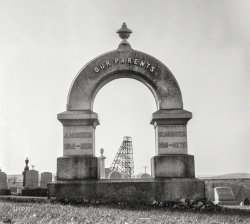
- Ice Baby: 1941
- January 1941. "Workers' houses near Pittsburgh Crucible Steel Company in Midland, Pennsylvania." Acetate negative ... Posted by Dave - 12/27/2018 - 12:00pm -
![Ice Baby: 1941 January 1941. "Workers' houses near Pittsburgh Crucible Steel Company in Midland, Pennsylvania." Acetate negative by Jack Delano. View full size.
BrrrrrrrrrHaving grown up in Philadelphia, I can say the smart people are INSIDE!
Red is grey and yellow whiteBut we decide which is right
And which is an Illusion.
So, the traffic signal is on red or green?
The Non-Romantic Look of Cold and SnowGrey, cold, bleak. Delano is awfully good at bringing out that look. (And this is a great picture, right down to Mother and child at the window).
Wikipedia notes that, after the War, Delano settled in Puerto Rico. The antithesis of the cold, snow, bleak we see in these pictures. Hmm.
Stamped sheetmetal sled runners and uprightsCommon until well into the '60s, the runner sliding surfaces were just one edge of an L, often not well-made enough to be actually straight upright. And they were bendy. Not very good unless everything was frozen completely solid. The L flange needed to be much wider for snow. Kind of useless actually.
As kids we were so envious of the kids from next door. They had two sturdy sleds built by their father - the sliding surface runner was inch-wide metal strap firmly screwed to solid wood uprights - no bending. They made our store-bought sleds seem second rate and slid far further.
Re traffic lights: everywhere in the world, red is the top light!
[Incorrect. Back in the day, green was the top light on many a stoplight. - Dave]
Incorrect? Hardly, from my and any reasonable point-of-view.
Saw your other post after I sent mine, so I'll just ask you - back in what day, exactly? You need to provide some real evidence, like a street photo, of these rarely-occurring anomalies. tterrace's example is of a one-off design that never made it commercially. Hardly proof of widespread green light on top traffic signals even "back in the day".
After spending several hours last night looking for some evidence myself of your bald assertion, following my reading of an earlier Shorpy post which I actually read after the one I responded to, I was unable to find anything that sways me to it. Not a thing.
There is of course the Wikipedia entry about the Irish green light in Syracuse NY, and the debacle over that one light was in the 1920s! That had to be done as a special case because it did not meet the New York State Dept of Transportation guidelines in 1925. Maybe there's an anorak website with every combination of everything that ever happened in traffic light design somewhere - I couldn't find it. It would hardly matter if I had in the greater scheme of things.
So it seems no more than somewhat likely that green light on top might have been used by a mere few municipalities in the US, and probably before 1920. Nobody else worldwide bothered to get it wrong! Due to local financial concerns, sure, some anomalies may have not been replaced for years, confusing the color-blind and those folk who never can quite remember their left from right or east from west. Those who "remember" green on top are in that category, I'd suggest. Having conducted many safety hearings following accidents in my career, one thing I do know is that most people are quite unobservant, because their recounting of incidents never matches exactly, and some are fantasy.
There is all sorts of history as to why red is placed on top, both for longer visibility in fog due to color sensitivity and earlier detection by the motorist cresting a hill before an intersection, and so on. Not to mention catering to the 20% of males with red/green color-blindness by standardization of position.
A traffic light in Philadelphia in 1941, though? Get away with you. I'd bet money it was standard configuration.
An extremely minor use of green on top may have occurred, sometime, somewhere, a hundred years ago. I'll agree to that. But as a useful reaction to my and others' comments, to call universal use of red on top "incorrect" is pedantry. I know it when I read it, because I tend to be a pedant myself. Comes from being a professional engineer for 42 years and a manager of them for half that. So who cares about the .01% of lights that might have been upside down long ago? Not even me.
You own the site - you can claim right by might. However, if you insist on calling me incorrect, using the reason that very occasional anomalies once existed, remove my entire post forthwith, please. There are civil ways of mentioning occasional occurrences of something as points of interest. To make a bald impolite assertion of "incorrect" I cannot accept and won't be associated with in this case, thanks all the same.
[Green-on-top stoplights were (literal) fixtures of my childhood. On cross-country family trips in 1965 and 1971, I'd announce them to the rest of the car whenever I saw one, mostly in small towns of the American West. It took less than a minute of googling to find the ads below -- from the 1930 trade publication "Municipal Index," both showing green-on-top signals. Which I suspect comprised a substantial percentage of early 12-lamp fixtures. - Dave]
Click to enlarge.
On every cornerThe mom and baby are likely watching the kid on the sled, who's eyeballing the photographer right back. Fun family scene. Then there's that guy who's on every corner in these shots, the needs-a-drink guy. My seasonal best wishes go out to him this year.
In Defense of the Flexible FlyerThe sled which looks like to me as my old friend, Flexible Flyer, and panned as kind of useless actually by conundrum was not useless but loads of fun for my family.
Bought originally around 1940 for my older sister and used into the late 50's by my younger brother was a platform for daring do down the hills of Clifton Park.
Through the years there were many combinations of family and friends who rode the sled downhill towards Belair Road off a green adjacent to Clifton Park Terrace. The best snows were on weekends when Dad would be off and he would come along.
My father had taught my sister then my sister taught me and I in turn taught my brother.
When we were nearing the freezing point Dad took us to a store at Mareco and Belair that sold hot chocolate where he would order up us kids a round while he took Mom a few doors up to a local tavern for a shot of rye and a Gunther beer for himself and for Mom an Arrow draft beer.
Someday I'll have to get into the discussions my parents and my aunts and uncles on my father's side had about Gunther and Arrow beer when they came to our house for a Sunday afternoon visit.
Aunt Ana was neat since after drinking a beer she could blow up a balloon and it floated to the ceiling. Uncle Donald was cool too since he always had a few risque jokes to tell so he would give the kids a dime each to go buy some candy at the confectionary store up the street. At the time that bought a lot of candy since they were all penny candies and some were even 2 for a penny.
(The Gallery, Factories, Jack Delano, Kids)](https://www.shorpy.com/files/images/SHORPY-8c04464a.thumbnail.jpg)
- Academy of Music: 1907
- ... more than four days in 1907 to hitchhike from Saginaw to Pittsburgh.
My home town. The building burned down April 17, 1917. A ... Posted by Dave - 03/17/2021 - 4:59pm -
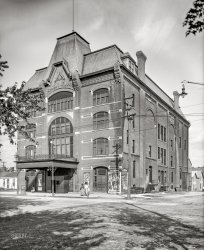
- The Three Amigos: 1908
- ... date of this picture.
#1 - b.17 Aug 1899 d.Dec 1972 Pittsburgh
#2 - b. 7 Aug 1901 d.Jul 1980 Huron, SD
#3 - b.15 Mar 1897 d.Jan ... Posted by Dave - 09/07/2011 - 8:37pm -
![The Three Amigos: 1908 November 29, 1908. Boys working in the Eureka Cotton Mills at Chester, South Carolina. Rob Dover (tallest boy) has been in mill eight or nine years. Melvin Reilly (middle) in mill one year. Boyd McKowan is about 15 years old. Been in mill five years. Witness Sara R. Hine. View full size. Photo by Lewis Wickes Hine.
Found themSome records for Robert Dover:
#1 - b. 10 Nov 1894, d. Mar 1981 York, SC
#2 - b. 08 Mar 1893, d. Feb 1958 location unknown
Both had SS# issued in South Carolina.
If I change Boyd's last name to McGowen (k to g and a to e) I find:
b. 12 Aug 1896, d. Jun 1971 Michigan, SS issued in Michigan.
[Good work! Shorpy salutes you. - Dave]
Rob Dover and Boyd McKowanRob Dover and Boyd McKowan turned up nothing in a SSDI search result. However, I got four hits on Melvin Reilly. Seems like Melvin is a unique name. Three out of four records may match the date of this picture.
#1 - b.17 Aug 1899 d.Dec 1972 Pittsburgh
#2 - b. 7 Aug 1901 d.Jul 1980 Huron, SD
#3 - b.15 Mar 1897 d.Jan 1963 New Jersey
[Good work! Maybe Boyd's last name was really McGowan. - Dave]
Rob DoverActually, Robert (Rob Dover) died in 1958. This is the correct reference for him. He was my great great uncle. He worked for Springs Industries his entire life.
Also, his younger brother, John Washington Dover (known as Wash and Washey in the Lewis Hine picture from the same visit to Eureka in 1908), was born in 1899 and died in 1937 at the Gayle mill, also in Chester. That photo is available on the Lewis Hine descendants site.
Also, Lewis appeared not familiar with Southern pronunciations of traditional Scottish names. Boyd McKowan's name should be spelled McKeown. His descendants also still live around Chester.
Boyd McKeownThanks to the spelling suggestion from John Robinson, from the SSDI we find:
Boyd McKeown
born: 14 Jul 1892
died: Mar 1967
last residence: Great Falls, Chester, SC
state of SSN issue: South Carolina
(The Gallery, Kids, Lewis Hine)](https://www.shorpy.com/files/images/01457uu.thumbnail.jpg)
- Little Dipper: 1915
- ... therefore now possible to ride a bike from Washington to Pittsburgh on these two trails.
(The Gallery, D.C., Kids, Natl Photo, ... Posted by Dave - 07/12/2018 - 3:53pm -
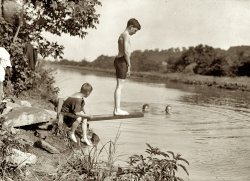
- Dome Alone: 1910
- ... was rechristened 1 Mellon Plaza, but only the folks from Pittsburgh called it that. Locally it was still "The Dome Building." The Ritz ... Posted by Dave - 09/21/2015 - 9:16am -
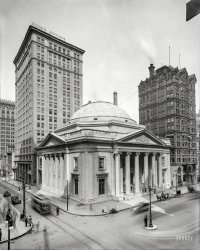
- Pittsburgher Inn
- ... Located at Route's 19 and 108 about 40 miles north of Pittsburgh. The picture looks to be late 30s or early 40s. Other amenities ... Before I-79 was built, Route 19 was the major road between Pittsburgh and Erie and was heavily traveled. View full size.
Earlier ... Posted by Segue - 10/05/2011 - 5:02pm -

- Central Furnace Works: 1908
- ... and Harvard Avenues, along the old Cleveland & Pittsburgh line of the Pennsy road. The location of these obscure blast ... Posted by Dave - 10/12/2012 - 5:52pm -
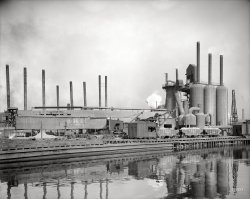
- Detroit Rubber Works: 1908
- ... photo, a new development team led by Detroit native and Pittsburgh Steeler Jerome “The Bus” Bettis obtained development rights to ... Posted by Dave - 09/04/2021 - 10:41am -
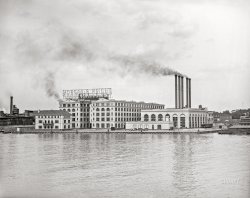
- Brakeman in Black: 1939
- ... by the Pennsylvania RR for 49 years and had the run from Pittsburgh to Oil City, PA.
Western Pacific Camera is looking SW, but ... Posted by Dave - 04/25/2018 - 1:02am -
![Brakeman in Black: 1939 June 1939. Carlin, Nevada. "Brakeman on the Union Pacific Challenger." Photo by Dorothea Lange for the Farm Security Administration. View full size.
40.709083N, 116.117243W -- looking SWIn 1939 Dor0thea Lange apparently, like Arthur Rothstein, drove across Nevada along the Lincoln Highway (now Interstate 80) taking pictures. In the town of Carlin, where B Street crosses the railroad tracks going south to West Main Street seems like it might have been the location where this particular image was photographed -- her camera pointed roughly southwest. A second train track now runs alongside. I wonder if the base of the tall old signal tower is the white electrical box there now.
Does he have all his fingers?A brakeman's job was historically very dangerous with numerous reports of brakemen falling from trains, or being run over or crushed by rolling stock. As rail transport technology has improved, a brakeman's duties have been reduced and altered to match the updated technology, and the brakeman's job has become much safer than it was in the early days of railroading. Individually operated car brakes were replaced by remotely-operated air brakes, eliminating the need for the brakeman to walk atop a moving train to set the brakes. Link and pin couplings were replaced with automatic couplings,and hand signals are now supplemented by two-way radio communication.
BrakemanMy uncle, who was a conductor on freight trains, said there were many accidents with the loss of limb as well as life. He would relate that in the station house you could see limbs laid against the wall when the injured were brought in. As a conductor, he would walk the roofs of the cars in all kinds of weather conditions and set the brakes on the cars individually as well as the brakeman. He was employed by the Pennsylvania RR for 49 years and had the run from Pittsburgh to Oil City, PA.
Western PacificCamera is looking SW, but the curve is the one at 40.71047N 116.107W, on the Western Pacific. In June 1939 train 88 was due out of Carlin at 1143 PST. The sign down there likely says West Carlin One Mile.
Passenger Train ConductorPart of a passenger train conductor's job was to be a brakeman. That job included "lining a route" for the train he was assigned to.
The conductor in the picture is part of the train crew assigned to the "Challenger", a named train on the Union Pacific Railroad.
A brakeman on a freight train would not be wearing a uniform like the one in the picture.
[Their caps say BRAKEMAN. - Dave]
(The Gallery, Dorothea Lange, Railroads)](https://www.shorpy.com/files/images/SHORPY-8b33534a.thumbnail.jpg)
- Judges Avert Probe: 1913
- ...
William A. Blakeley was District Attorney in Pittsburgh. In an unusual case in 1913, his office was accused of negligence by a retiring grand jury. From the Pittsburgh Press, Jan. 23, 1913:
Czapka The word in Polish for a hat ... Posted by Dave - 06/21/2019 - 5:01pm -
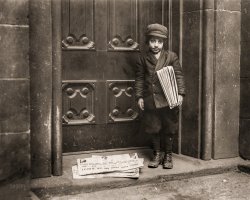
- Some Assembly Required: 1906
- ... would be launched on April 6, GLEW's hull number 16 for Pittsburgh's Jones & Laughlin Steel Company and operated by its subsidiary, ... Posted by Dave - 06/10/2013 - 1:16am -
![Some Assembly Required: 1906 1906. "Great Lakes Engineering Works, Ecorse, Michigan. Steamer James Laughlin at left." Now where'd I put that instruction sheet? View full size.
[Owner name here] ChallengerHull 17 is still sailing in steam. She's had many names. Launched Feb. 7, 1906 as William P. Snyder, later Elton Hoyt II, Alex D. Chisolm, Medusa Challenger, Southdown Challenger, and St. Mary's Challenger. Built as a traditional bulker, later converted to a specialized cement carrier.
She currently has a 4 cylinder Skinner Unaflow (or Uniflow) steam engine.
Note that many Great Lakes freighter names were reused on several different boats, thus if you try to look up a specific boat name, you need to check the dates that a boat carried the name. On the lakes, renaming apparently had no superstitious stigma.
They are bigger nowI just watched the 1014 foot long PAUL R TREGURTHA come into Duluth. Zounds, what a large ore boat!
Probably early winterThis is probably early winter 1906 at Ecorse, since the James Laughlin would be launched on April 6, GLEW's hull number 16 for Pittsburgh's Jones & Laughlin Steel Company and operated by its subsidiary, the Interstate Steamship Company of Duluth. Sold Canadian in 1964 and renamed Helen Evans for Captain Norman Reoch's Hindman Transportation Co., Ltd., of Owen Sound, Ontario, she was scrapped in 1981 at Cartagena, Colombia. The vessel to the right on the ways is almost certainly the Michigan, hull number 20, being constructed for the Grand Island Steamship Company, part of the Cleveland Cliffs Iron Company, which would launch on May 26. Also sold Canadian in 1965 and renamed Goudreau, she would last until 1969 when scrapped at Santander, Spain. The vessel to the far left is the Charles B. Hill of 1878, launched as the Delaware and previously featured on Shorpy, being rebuilt into a more modern appearing freight carrier for John Boland of Buffalo. Less than a year after this photograph was taken, the Hill, coal-laden and towing the barge Commodore, would be purposely run aground when her seams began to open during a gale on November 22, 1906. All crew survived. Her remains still exist in shallow water about a half mile offshore of North Madison, Ohio, west of Ashtabula, in Lake Erie.
Not their most famous shipTragedy (and subsequently, Gordon Lightfoot) cemented the SS Edmund Fitzgerald's status as GLEW's most famous ship. Launched in 1958, the Fitzgerald famously went down in high [inland!] seas on Lake Superior, November 10, 1975.
Here's a grim tidbit I learned only within the past decade. The lake's average temperature hovers around 40˚F. This temperature is cold enough to prevent gases from forming in corpses--gases that would, normally, cause a dead body to float to the surface. Thus, Lightfoot's lyrics are not merely poetic when they relate, "The lake, it is said, never gives up her dead."
(The Gallery, Boats & Bridges, DPC, Industry & Public Works)](https://www.shorpy.com/files/images/SHORPY_4a21308a.thumbnail.jpg)
- Jones & Laughlin: 1941
- ... I used to ride the 16A Ambridge bus to my job in Pittsburgh.
Steel and Football Aliquippa's main industry today is ... Posted by Dave - 10/24/2019 - 3:23pm -
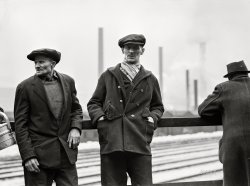
- League of Nation: 1917
- ... style to prevent him from scoring and Jones tagged the Pittsburgh representative. When the men arose Griffith waved Farr across the ... Posted by Dave - 08/22/2012 - 8:38pm -
![League of Nation: 1917 1917. Washington, D.C. "Congressional baseball game. President and Mrs. Wilson." Harris & Ewing Collection glass negative. View full size.
Donkey Kicks Elephant
'Donkey' Kicks 22 to 21
Wilson Tosses the Sphere
The Democratic donkey had a kick in all of its figurative four legs yesterday. He won the annual congressional baseball game from the Republicans by a ninth-inning rally - won it after the President of the United States had given up hopes for his party and returned with Mrs. Wilson to the White House.
The score was 22 to 21, but, despite the fact that 43 men crossed the counting board, it was the most exciting congressional game for years. The entire proceeds are to go to the Red Cross, and in addition to the sum realized from the gate receipts, hundreds of dollars more were obtained from contributions and from the sale of score cards.
President Wilson and Mrs. Wilson sat through eight innings of the game. he was cheered when he caught a ball and threw it out to the Umpire Clark Griffith before the game started. In the seventh inning, Representative Sydney Mudd, pitcher for the Republicans, drove a foul ball into the presidential box, which Mr. Wilson barely managed to dodge.
Vice President Marshall sat in a box behind the catcher and Speaker Champ Clark was perched far back in the grand stand, and rooted for the Democrats. Members of the diplomatic corps, cabinet members, army and navy officials, members of Congress, and officialdom in general attended the game.
Marvin Jones, of Amarillo, Tex., doesn't like Republicans. He defeated his Republican opponent in the 1916 election by 30,000 majority and defeated the Republicans yesterday almost single handed. Seven times Jones faced Pitcher Sydney Mudd and seven times he drove out ringing base hits. Four times the Texan led rallies which lifted the Democrats out of the slough of despond. He stole five bases, and once he took a lead off base in order to draw a throw and give a Democratic runner a chance to score.
...
Umpire Clark Griffith had a busy day. In the eighth inning McClintic tackled Farr in football style to prevent him from scoring and Jones tagged the Pittsburgh representative. When the men arose Griffith waved Farr across the counting station and the Democrats gathered around Griffith and inserted some remarks into the record.
...
In the line-up were the following: Democrats: Jones, of Texas, third base; Bankhead, Alabama, left field; [Pat] Harrison, captain, short stop and pitcher; Nicholls, South Carolina, center field; McClintic, Oklahoma, catcher; Rouse, Kentucky, first base; Webb, North Carolina, pitcher and shortstop; Whaley, South Carolina, second base; Sears, Florida, right field; Mr. Harrison concluded to be pitcher before the game was over, and being captain, Mr. Webb had to retire, much against his will.
Republican line-up: Miller, Minnesota, captain, shortstop; Morin, Pennsylvania, first base; Mudd, Maryland, pitcher; Johnson, South Dakota, catcher; Sanders, Indiana, center field; Ireland, Illinois, left field; Bacharach, New Jersey and Elston, California, third base; Vestal, Indiana, right field; Norton, North Dakota and Kalaniaole, second base.
Washington Post, July 1, 1917
I laughed, I criedDave, you have out-done yourself in the clever title department with this one.
Party FoulOne wonders if Congressman Mudd didn't actually take aim for Wilson. The election of 1916 had been a very close and divisive race!
On a side note, Wilson was a former ball player himself, having been forced to quit because of frail health, and I have read somewhere he was the first president to attend a World Series game.
(The Gallery, D.C., Harris + Ewing, Politics, Public Figures, Sports)](https://www.shorpy.com/files/images/09154a.thumbnail.jpg)























